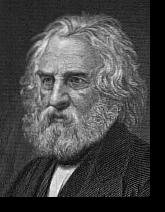In 1835, Mr. Longfellow was called to succeed George Ticknor as Professor of Modern Languages and Literature in Harvard College. He took another European journey, by way of preparation, and visited the north of Europe with his young wife, who died at Rotterdam, Nov. 29, 1835. Under the shadow of this great sorrow, Mr. Longfellow returned to Cambridge, and began his college duties, in 1836. In 1839, appeared the exquisite prose poem, "Hyperion." (Early New England People, pp. 235-236)
Longfellow was an american poet who was instrumental in reestablishing a public audience for poetry in the United States. He was born in Portland, Maine (then in Massachusetts). In 1831, he married Mary Storer Potter, whom he had known as a schoolmate. When he saw her at church upon his return to Portland, he was so struck by her beauty that he followed her home without courage enough to speak to her. With his wife, he settled down in a house surrounded by elm trees. He expended his energies on translations from Old World literature and contributed travel sketches to the New England Magazine, in addition to serving as a professor and a librarian at Bowdoin.
In 1834, he was appointed to a professorship at Harvard and once more set out for Europe by way of preparation. This time his young wife accompanied him. The journey ended in tragedy. In Rotterdam, his wife died, and Longfellow came alone to Cambridge and the new professorship. The lonely [Longfellow] took a room at historic Craigie House, an old house overlooking the Charles River. It was owned by Mrs. Craigie, an eccentric woman who kept much to herself and was somewhat scornful of the young men to whom she let rooms. But she read widely and well, and her library contained complete sets of Voltaire and other French masters. Longfellow entered the beautiful old elm-encircled house as a lodger, not knowing that this was to be his home for the rest of his life. In time, it passed into the possession of Nathan Appleton. Seven years after he came to Cambridge, Longfellow married Frances Appleton, daughter of Nathan Appleton, and Craigie House was given to the Longfellows as a wedding gift.
Longfellow was devastated in 1861 when his second wife was burned to death in a household accident. [She died of burns she received when packages of her children's curls, which she was sealing with matches and wax, burst into flame.] He commemorated her shortly before his own death with the sonnet The Cross of Snow (1879).Longfellow received wide public recognition with his initial volume of verse, Voices of the Night (1839). His subsequent poetic works include Ballads (1841), which includes the poems The Wreck of the Hesperus, The Village Blacksmith, The Skeleton in Armor, and Excelsior; and three notable long narrative poems on American themes: Evangeline (1847), The Song of Hiawatha (1855), and The Courtship of Miles Standish (1858). Longfellow's other works include Tales of a Wayside Inn (1863), containing the well-known poem Paul Revere's Ride. In 1884 a bust of Longfellow was placed in the Poets' Corner of Westminster Abbey in London. He was the first American to be thus honored.
Longfellow graduated with Nathanial Hawthorne at Bowdoin college in 1825.
A very good web page on HWL...
http://EclecticEsoterica.com/longfellow.html
|
